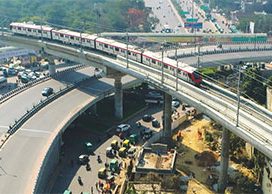As is known, Hyderabd Metro once completed will be one of the best mass rapid transport projects in the world, especially built on the PPP model. There are two hundred mass transit systems in the world and out of these, less than half a dozen are built on this model. Mostly, these are government funded and managed projects for the survival of the city. Beyond a certain point, railways cannot handle mass transport and roads also have their limitations. In transportation engineering, it is typically said that one rail line is equal to seven bus lanes or twenty four car lanes. No city can afford twenty four car lanes; and in terms of energy efficiency, metros are five times energy efficient, but are highly capital intensive with long periods of construction.
Out of the top two hundred mass transport systems in the world, only the ones in Singapore, Hong Kong, Tokyo, and Taipei are making money; the rest are all heavily funded and subsidised by the government. Originally even our project was also termed as a government project by the Delhi metro. So after studying all these and looking at a few successful financial models, we adopted a similar model here. Ground floor & the stations will be used for metro rail, and the remaining for the commercial utilization. So in our revenue model, 50-55% of revenue is coming from passenger fares, 45% from property development that we have allowed the concessionaire today and 5% from advertisements and other miscellaneous features like parking etc. Whatever is constructed by the concessionaire cannot be sold; the company can only lease it out during the concession period. At the end of the concession period, the whole facility will come back to the government.

The concession period is for on initial period of 35 years which can be further extended to 25 years (i.e.; 35+25). Within five years of the concession period, one will see a sea change happening. The main challenge is how can you make the entire project financially viable? There are going to be initial losses in the first six to seven years, but it has to be financially viable in the long term. When we studied the system, we found that in mass transit system, you have to design the system for peak hour traffic but during non-peak hours your assets remain idle. This is a challenge, and to solve this problem, we adopted a strategy: Firstly, increase the peak period. For some people, money is important, and for others time is important. So we have given a special provision in our concession agreement, where up to four hours a day is declared as peak hours with 25% hike in fares. If you declare four hours as peak hours, than you will have to double the non-peak hours i.e. eight hours. And thus during this period, you will have to give 25% discount.

Hyderabd Metro has given us an opportunity to redesign the City as people-friendly, green and an attractive destination. So, if we are able to provide all required amenities for people at the metro stations itself, it will reduce the congestion on roads. Many concepts are taken from different metro stations around the world. Initially, even Bangkok had an elevated metro like ours. They realized later that there was a lot of unused space underneath. As per IRC (Indian Road Congress) standard, 5.5m height is required for the track. However, the height in Hyderabd Metro is 8.5m. There would be skywalks in the remaining 3m space, directly connected to malls, schools etc. In all our metro stations, we have escalators and elevators and four entry points. The design of the stations are different from one another and there are stations at every one and half kilometer on an average.

At one point of time, the shopping malls were slowly crumbling because there was no accessibility and there were traffic congestions. Initially people were opposing the metro train because they believed that the metro would bring in additional congestion. And on top of all, we are barricading the roads. It is now understood by the citizens that the metro stations will provide better connectivity through skywalks to buildings, schools, colleges, hospitals, workplaces and residential buildings. These places are now accessible, which means we are increasing the efficiency of the city. So when you get down from the metro station, you have to just walk a bit. We are using this as an opportunity to rejuvenate the city as eco and people friendly.
We will be providing facilities like bicycle stations to help with last mile connectivity. We are going to have street furniture as well as open spaces, so if you provide all these day-to-day requirements, it will help decongest the system and increase the productivity of the City.
 TrafficInfraTech Magazine Linking People Places & Progress
TrafficInfraTech Magazine Linking People Places & Progress



